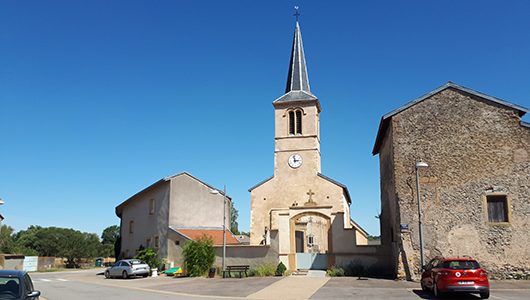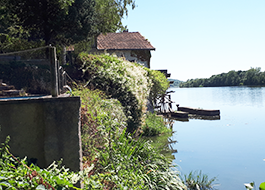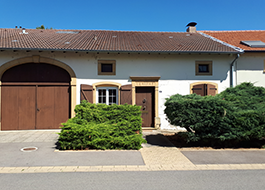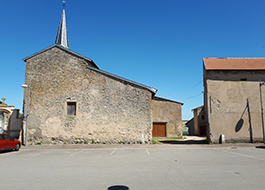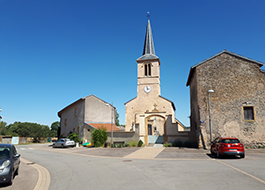Malroy
Durée visite : 40 minutes
Moyen : Pédestre
Le village dépendait du Pays messin et faisait partie du Haut Chemin. Nos ancêtres nommaient ainsi la route de Bouzonville. Au Moyen Âge, les pèlerins du pays Messin empruntaient cette voie pour aller à Sainte-Barbe, y prier leur patronne. Thiébault de Heu, maître échevin de la ville de Metz acheta Malroy. C’était désormais le fief de la famille de Heu, dont l’hôtel se trouve rue de la Fontaine à Metz. Il passe en 1728 aux Jobert dont l’hôtel est situé rue du Chanoine-Collin.
The village depended on the Pays Metz and was part of the Haut Chemin. Our ancestors named the road to Bouzonville. In the Middle Ages, pilgrims from the Messinian region took this route to go to Sainte-Barbe, to pray to their boss there. Thiébault de Heu, master alderman of the city of Metz bought Malroy. It was now the stronghold of the de Heu family, whose hotel is located rue de la Fontaine in Metz. In 1728 he passed to the Joberts whose hotel is located rue du Chanoine-Collin.
Das Dorf war vom Pays Metz abhängig und gehörte zum Haut Chemin. Unsere Vorfahren nannten die Straße nach Bouzonville. Im Mittelalter nahmen Pilger aus der messinischen Region diesen Weg, um nach Sainte-Barbe zu gehen und dort zu ihrem Chef zu beten. Thiébault de Heu, Alderman der Stadt Metz, kaufte Malroy. Es war jetzt die Hochburg der Familie de Heu, deren Hotel sich in der Rue de la Fontaine in Metz befindet. 1728 ging er an die Joberts über, deren Hotel sich in der Rue du Chanoine-Collin befindet.

D’azur au mont de six coupeaux d’or sur lequel grimpent deux écureuils affrontés d’argent, le tout surmonté de deux étoiles d’or.
Ce sont les armes de la famille Poutet qui a possédé Malroy aux XVIIe et XVIIIe siècles.
Azure on the mount of six gold cups on which climb two squirrels facing Argent, the whole surmounted by two gold stars.
These are the arms of the Poutet family who owned Malroy in the 17th and 18th centuries.
Azurblau auf dem Berg von sechs Goldbechern, auf denen zwei Eichhörnchen auf Argent klettern, das Ganze von zwei goldenen Sternen überragt.
Dies sind die Arme der Familie Poutet, der Malroy im 17. und 18. Jahrhundert gehörte.
Les points de visites
.
Primitivement destiné au broyage du grain, le moulin à eau va connaître d’innombrables applications : broyage du malt, du pastel, des écorces ou tan, des olives, des graines de moutarde ou d’œillette. Une innovation plus importante encore apparaît au XIe siècle. L’emploi des cames pour transmettre le mouvement. Equipé de ce dispositif, l’arbre horizontal de la roue hydraulique transforme celle-ci en un véritable moteur industriel, le seul en usage jusqu’à l’invention de la machine à vapeur. Le moulin de Malroy reste en activité jusqu’en 1950, quand le dernier meunier Jules Goullon prend sa retraite. Ses ancêtres y travaillaient déjà au 18e siècle.
Primarily intended for grinding grain, the water mill will have countless applications: grinding malt, pastel, bark or tan, olives, mustard or carnation seeds. An even more important innovation appeared in the 11th century. The use of cams to transmit movement. Equipped with this device, the horizontal shaft of the water wheel transforms it into a real industrial engine, the only one in use until the invention of the steam engine. The Malroy mill remained in operation until 1950, when the last miller Jules Goullon retired. His ancestors were already working there in the 18th century.
Die Wassermühle ist in erster Linie zum Mahlen von Getreide gedacht und wird unzählige Anwendungen haben: Mahlen von Malz, Pastell, Rinde oder Bräune, Oliven, Senf oder Nelkensamen. Eine noch wichtigere Neuerung erschien im 11. Jahrhundert. Die Verwendung von Nocken zur Übertragung von Bewegungen. Ausgestattet mit dieser Vorrichtung verwandelt die horizontale Welle des Wasserrads es in einen echten Industriemotor, der bis zur Erfindung der Dampfmaschine als einziger im Einsatz ist. Die Malroy-Mühle blieb bis 1950 in Betrieb, als der letzte Müller Jules Goullon in den Ruhestand ging. Seine Vorfahren arbeiteten dort bereits im 18. Jahrhundert.
.
.
Le linteau est un élément architectural destiné à soutenir les matériaux du mur au-dessus d’une porte, un portail ou une fenêtre. L’entrée des maisons étant un élément important et symbolique, le linteau était parfois décoré. Ces décors étaient le plus souvent liés à l’activité du propriétaire. Viticulteurs, artisans témoignaient ainsi de leur profession. On y avait parfois gravé la date de construction ou de reconstruction de la maison. La date est parfois accompagnée d’initiales ou du nom du propriétaire. Des artisans italiens furent très actifs en Lorraine au 18e. Spécialistes de la pierre, ils furent invités par le roi Stanislas pour ses projets architecturaux. Après sa mort, ils louèrent leurs services aux particuliers. Ces décors sont encore fréquents une grande partie du 19e.
The lintel is an architectural element intended to support the materials of the wall above a door, a portal or a window. The entrance to the houses being an important and symbolic element, the lintel was sometimes decorated. These decorations were most often linked to the activity of the owner. Wine growers and artisans thus testified to their profession. It was sometimes engraved with the date of construction or reconstruction of the house. The date is sometimes accompanied by initials or the owner’s name. Italian artisans were very active in Lorraine in the 18th century. Stone specialists, they were invited by King Stanislas for his architectural projects. After his death, they hired their services to individuals. These decorations are still common much of the 19th century.
Der Sturz ist ein architektonisches Element, das die Materialien der Wand über einer Tür, einem Portal oder einem Fenster tragen soll. Da der Eingang zu den Häusern ein wichtiges und symbolisches Element war, wurde der Sturz manchmal dekoriert. Diese Dekorationen waren meistens mit der Tätigkeit des Eigentümers verbunden. Winzer und Handwerker zeugten damit von ihrem Beruf. Es wurde manchmal mit dem Datum des Baus oder der Rekonstruktion des Hauses eingraviert. Das Datum wird manchmal von Initialen oder dem Namen des Besitzers begleitet. Italienische Handwerker waren im 18. Jahrhundert in Lothringen sehr aktiv. Steinspezialisten wurden von König Stanislas zu seinen Architekturprojekten eingeladen. Nach seinem Tod stellten sie ihre Dienste für Einzelpersonen ein. Diese Dekorationen sind im 19. Jahrhundert noch immer weit verbreitet.
.
C’est à partir du dernier tiers du XIIe siècle que les textes signalent des édifices qualifiés de maisons fortes ou maison fortifiées. Ces édifices, qui ne sont pas des châteaux, sont plus qu’une simple résidence. Ce phénomène se poursuivra largement dans la première moitié du XIIIe et prendra fin au début du XVIe. Elles peuvent présenter l’aspect d’une maison solide avec tours, ou avoir l’apparence d’une bâtisse construite de bric et de broc. Elles appartiennent à des cadets, à des parents ou à des alliés de grandes familles seigneuriales. Par définition, elles sont les résidences de la petite aristocratie. Sans doute ici résidaient les Heu ou leurs représentants. Ils s’y réfugiaient en cas de troubles politiques ou d’épidémie. C’était le confinement à la campagne.
It is from the last third of the 12th century that the texts indicate buildings qualified as fortified houses or fortified houses. These buildings, which are not castles, are more than a simple residence. This phenomenon will largely continue in the first half of the 13th century and end at the beginning of the 16th century. They can have the appearance of a solid house with towers, or have the appearance of a building constructed from odds and ends. They belong to cadets, relatives or allies of great seigneurial families. By definition, they are the residences of the small aristocracy. No doubt here resided the Heu or their representatives. They took refuge there in the event of political unrest or epidemics. It was confinement in the countryside.
Es ist aus dem letzten Drittel des 12. Jahrhunderts, dass die Texte Gebäude bezeichnen, die als befestigte Häuser oder befestigte Häuser qualifiziert sind. Diese Gebäude, die keine Burgen sind, sind mehr als eine einfache Residenz. Dieses Phänomen wird sich in der ersten Hälfte des 13. Jahrhunderts weitgehend fortsetzen und zu Beginn des 16. Jahrhunderts enden. Sie können das Aussehen eines soliden Hauses mit Türmen haben oder das Aussehen eines Gebäudes, das aus Kleinigkeiten gebaut wurde. Sie gehören Kadetten, Verwandten oder Verbündeten großer Seigneurialfamilien. Per Definition sind sie die Residenzen der kleinen Aristokratie. Zweifellos residierten hier die Heu oder ihre Vertreter. Sie suchten dort Zuflucht bei politischen Unruhen oder Epidemien. Es war eine Beschränkung auf dem Land.
.
Construite en 1764 sur les vestiges d’une chapelle médiévale, l’église de Malroy fut remaniée en 1863, avec le rehaussement du clocher et le renforcement du plafond de la nef. Claude Martin de Julvécourt, alors Seigneur de Malroy, fit placer la même année une croix commémorative sur la façade extérieure du clocher. La nef est éclairée par six magnifiques verrières. Elles ont été réalisées à Metz, en 1869, par Raphaël MARÉCHAL, fils de Laurent. Mais là ne réside pas l’unique intérêt qu’offre ce sanctuaire. En effet, le clocher recèle à l’intérieur des trésors d’archéologie. L’étage inférieur de la tour, qui sert aujourd’hui d’entrée à l’église, et les deux parties adjacentes sont en fait la nef et les transepts de la chapelle médiévale. Elle fut construite en forme de croix grecque au XIe siècle. En pénétrant sous le porche, le regard est attiré par une voûte ogivale, en plein cintre, avec des nervures en boudin qui se croisent à la clef de voûte . Les nervures prennent appui sur des culots, décorés d’un côté par des têtes félines, et de l’autre par une ornementation végétale. De récents travaux ont mis à jour deux colonnes romanes du XIe siècle, et des vestiges de fresques du XVIe siècle. Deux oculi quadrilobés, de style gothique, percent les murs supérieurs de l’antique nef.
Built in 1764 on the remains of a medieval chapel, the church of Malroy was remodeled in 1863, with the raising of the bell tower and the strengthening of the ceiling of the nave. Claude Martin de Julvécourt, then Lord of Malroy, had a commemorative cross placed the same year on the exterior facade of the bell tower. The nave is lit by six magnificent glass roofs. They were made in Metz, in 1869, by Raphaël MARÉCHAL, son of Laurent. But this is not the only interest of this sanctuary. In fact, the bell tower conceals archaeological treasures inside. The lower floor of the tower, which today serves as the entrance to the church, and the two adjacent parts are in fact the nave and the transepts of the medieval chapel. It was built in the shape of a Greek cross in the 11th century. Entering the porch, the eye is drawn to a pointed vault, semicircular, with curved ribs that cross at the keystone. The ribs are supported on bases, decorated on one side by feline heads, and on the other by a plant ornamentation. Recent work has uncovered two Romanesque columns from the 11th century, and remains of frescoes from the 16th century. Two four-lobed oculi, in Gothic style, pierce the upper walls of the ancient nave.
Die 1764 auf den Überresten einer mittelalterlichen Kapelle erbaute Kirche von Malroy wurde 1863 mit der Anhebung des Glockenturms und der Verstärkung der Decke des Kirchenschiffs umgebaut. Claude Martin de Julvécourt, damals Lord of Malroy, ließ im selben Jahr ein Gedenkkreuz an der Außenfassade des Glockenturms anbringen. Das Kirchenschiff wird von sechs prächtigen Glasdächern beleuchtet. Sie wurden 1869 in Metz von Raphaël MARÉCHAL, dem Sohn von Laurent, hergestellt. Dies ist jedoch nicht das einzige Interesse dieses Heiligtums. Tatsächlich verbirgt der Glockenturm archäologische Schätze im Inneren. Das Untergeschoss des Turms, das heute als Eingang zur Kirche dient, und die beiden angrenzenden Teile sind das Kirchenschiff und die Querschiffe der mittelalterlichen Kapelle. Es wurde im 11. Jahrhundert in Form eines griechischen Kreuzes erbaut. Beim Betreten der Veranda wird das Auge auf ein spitzes, halbkreisförmiges Gewölbe mit gekrümmten Rippen gelenkt, die sich am Schlussstein kreuzen. Die Rippen werden auf Basen getragen, die auf der einen Seite mit Katzenköpfen und auf der anderen Seite mit einer Pflanzenverzierung verziert sind. Jüngste Arbeiten haben zwei romanische Säulen aus dem 11. Jahrhundert und Reste von Fresken aus dem 16. Jahrhundert entdeckt. Zwei vierlappige Okuli im gotischen Stil durchbohren die oberen Mauern des alten Kirchenschiffs.

